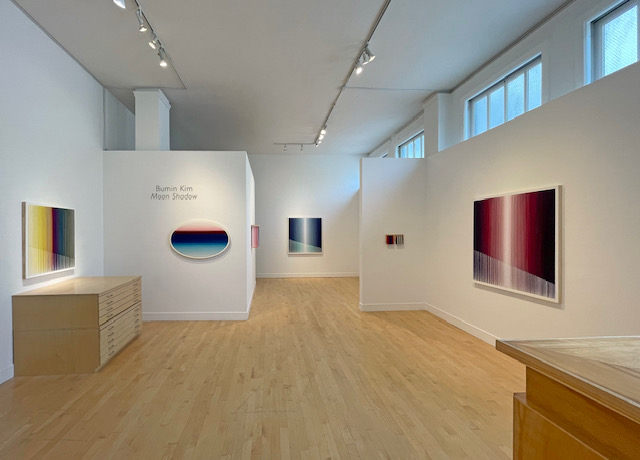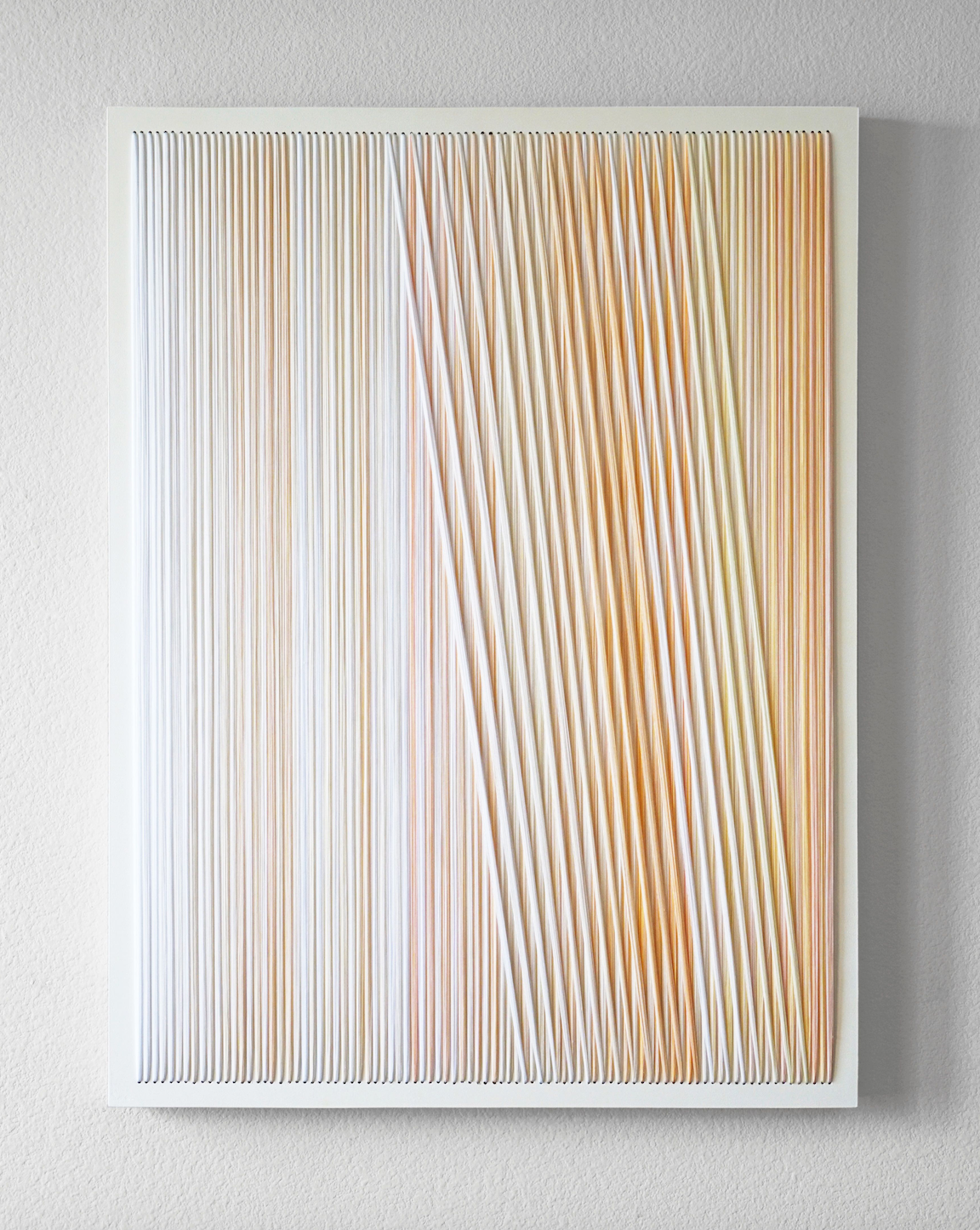 The first thing you notice about Bumin Kim’s sumptuous and meticulous compositions are their formal qualities—the bold chromatic choices, the unusual medium of thread on panel, the immaculate gradations of shading—but those attributes alone don’t explain the works’ powerful emotional resonance. As you spend more time with them and the artist who created them, you realize that just under the surface of these elegantly dynamic works are thematic undercurrents that lend a special poignancy. Yes, they are about light, line, and color, but they also speak to nostalgia, memory, homesickness, and family. Yes, they have pep and pop, but like Dvořák’s Rusalka, they sing a song to the moon. Although on first glance they come across as pure abstraction, they are in fact abstracted landscapes, and, much as in the oeuvre of the late Abstract Expressionist Joan Mitchell, they explore links between place, time, and emotion.
The first thing you notice about Bumin Kim’s sumptuous and meticulous compositions are their formal qualities—the bold chromatic choices, the unusual medium of thread on panel, the immaculate gradations of shading—but those attributes alone don’t explain the works’ powerful emotional resonance. As you spend more time with them and the artist who created them, you realize that just under the surface of these elegantly dynamic works are thematic undercurrents that lend a special poignancy. Yes, they are about light, line, and color, but they also speak to nostalgia, memory, homesickness, and family. Yes, they have pep and pop, but like Dvořák’s Rusalka, they sing a song to the moon. Although on first glance they come across as pure abstraction, they are in fact abstracted landscapes, and, much as in the oeuvre of the late Abstract Expressionist Joan Mitchell, they explore links between place, time, and emotion.
The genesis of the evocatively titled exhibition, Moon Shadow, at K. Imperial begins in Kim’s homeland, South Korea, where she was born in 1982. She hails from Busan, a majestic port city renowned for its beaches and colorful skyline. The interplay of sea, land, and built structure in Busan undergirds many of Kim’s paintings today. In them, she demonstrates a long- honed, exquisitely calibrated attunement to the textures of nature, changes in temperature and precipitation, grass, trees, buildings, and skyscapes. This sensitivity informed her studies in painting, sculpture, printmaking, and traditional Korean arts at Kyungsung University, where she earned her bachelor’s degree in fine art in 2004. In 2011 she moved to the United States and earned an M.F.A. degree from the University of North Texas, where her sister had studied piano.Subsequently, she taught art at the university until becoming a full-time artist in 2015. Today she lives and works in The Colony, a city in Denton County, Texas, near Dallas. The flat, arid plains and rolling hills of Texas also inspire her work, blending in a distant harmony with the Korean landscape of her youth. She is intrigued by the notion that the same moon that shines down upon her in America shines on family members who remain in Korea. She is fond of a 1946 poem by Yun Dong-ju, “A Night of Counting the Stars,” in which the poet observes: “I see memories in one star/and love in another/and loneliness/my longings/and poetry in each/and Mother in another…” It is an elegiac text, redolent of longing and melancholy. The sky is an important symbol for Kim, who titled a 2019 exhibition Walk the Sky (Women & Their Work Gallery, Austin, Texas). For her, the sky is a vessel containing matter and emotions. She does not see the night sky as black, but as gradations of gray, navy, purple, and silvery clouds floating on unseen currents. These chromatic gradations directly relate to the chromatic transitions in her artworks: subtle spectrum shifts from lemon to chartreuse to lime in the piece “Woodland I” or the trajectory of cerulean to sapphire to midnight in “Cascade.” The current exhibition marks the first time Kim has worked in a modified tondo format, lengthening the moon-like circle into an oval, the shape of an eye—the moon’s eye looking down. There is a graciousness in works such as “Moon Shadow #1” and “Moon Shadow #2” that is heightened by the gentleness of the shape itself.
The lines that rake across these panels appear hard-edged from a remove, but up close you see the sfumato and the sheer number of threads she deploys to achieve those delicate gradations of hue. The effect is pure, musical, lyrical. In fact, she refers to her stylistic fingerprint as her “visual voice.” The delicacy of these optical sonatas belies the time-consuming and labor-intensive process that go into their creation. One could call them wall sculptures, but Kim thinks of them as paintings because like paintings, they emerge from the mixing of color; it is just that she mixes color by layering hundreds of multicolored threads before a painted background, a process she began exploring in 2012. With their elemental shapes, they call to mind artists such as Josef and Anni Albers, Ellsworth Kelly, Frank Stella, and Bridget Riley, while their pillars of white and off-white evoke the mysticism and dematerialization central to the California Light and Space movement. They also nod to Op Art. As viewers walk around the pieces, viewing them from changing vantage points, the threads appear to shift in a kind of moiré effect, an optical illusion that imparts a kineticism and interactivity. A smaller piece, “Starry Night,” takes a different tack, with the bottom of the threads left unattached to the panel, such that they float freely, like a horse’s tail. Kim takes a philosophical view of her unconventional medium. A thread is not just a thin strip of fabric, it is a symbol of bridging a gap, of connecting people, places, or ideas that were previously disparate. A thread darns a tear. It repairs. A surgeon threading stitches into a patient’s body mends flesh so that healing can commence. As a child in Korea, Kim constantly saw her mother and other women sewing, so the medium of thread carries intimate autobiographical associations as well. All of these elements—the conceptual underpinnings of the material, the interactions of landscape and memory, the fondness we hold for a place far away—come together in Bumin Kim’s gorgeous compositions. With nuance and complexity they distill the moonrise, the gloaming, the liminal moods of Mother Nature, into potent, perhaps unexpectedly affecting evocations of our environment and its vicissitudes. There is perfectionism and suavity in these paintings, but at their core there is something more elemental:
heart.
—Richard Speer is a West Coast-based critic, curator, and author. His reviews and essays have appeared in ARTnews, ArtPulse, Art Papers, Visual Art Source, Salon, Newsweek, The Los Angeles Times, and The Chicago Tribune. His newest book is “The Space of Effusion: Sam Francis in Japan” (Scheidegger & Spiess), the companion publication to the exhibition he is co- curating at the Los Angeles County Museum of Art, “Sam Francis and Japan: Emptiness Overflowing” (Spring 2023). For more information, please visit www.richardspeer.com.

